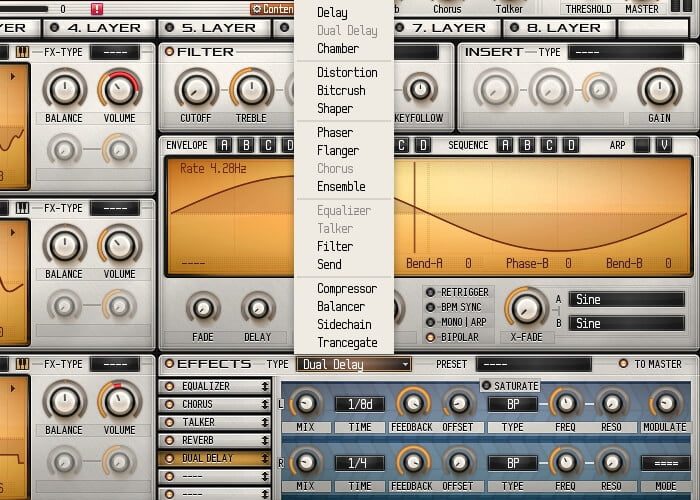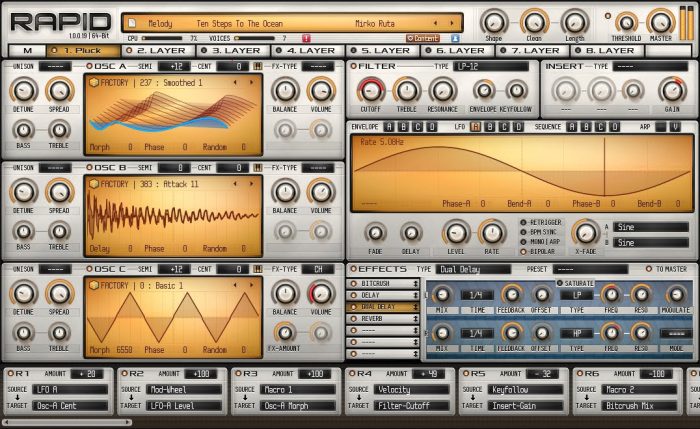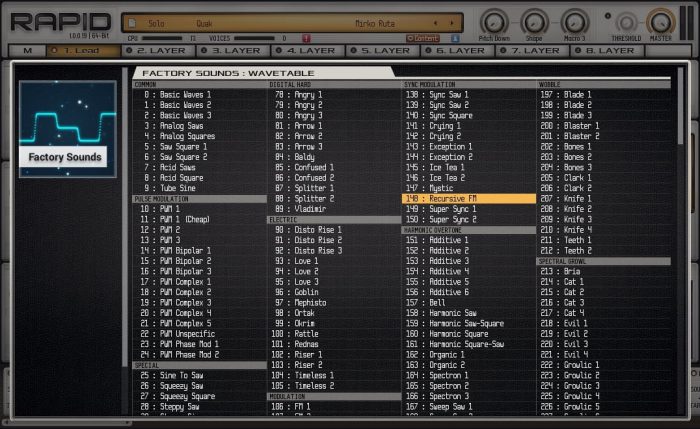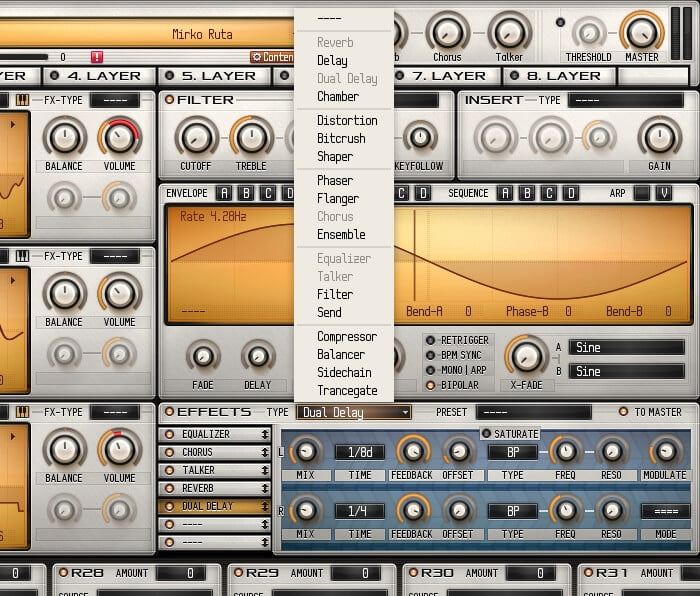Parawave Audio recently launched with the release of its first product, the Rapid synthesizer.
RAPID is a modern polyphonic hybrid synthesizer designed to bring together fast workflow and powerful synthesis techniques.
The unique layer engine that powers RAPID lets you shape and customize all aspects of your sounds, resulting in dynamic and fat patches, ready for production, performance or simply inspiration.
With up to 8 synthesis layers, Rapid aims to deliver stunning sound and fast workflow.
The first screen you see when opening Rapid is the master page. It has a presets browser, volume mixer for the layers, compressor, keyboard range view, and some controls for modifying the amp and filter for all layers at the same time.
Spread over various categories, the factory sound bank comes with over 650 presets. Most of the sounds are suited towards modern electronic music genres.
Each layer has 3 oscillators with morphable wavetables and multi-samples, a multi-mode filter, insert effect, 4 envelopes, LFOs and sequences, an arpeggiator, effects chain, and up to 32 modulation assignments.
In the screenshot above you can see a lovely 3D visual of the wavetable used for OSC A. You can toggle between 2D and 3D with a mouse click on the display. OSC C shows the 2D view, and a waveform of a multi-sample is shown in OSC B. Rapid has a nice way of visualizing things like waveform morphing and modulation.
You can set the wavetable position and start phase angle, and introduce randomness to the start position. In a similar way, you can set sample delay, start position, and random sample position for multi-samples. These are some great parameters for modulation to get a dynamic sound.
Rapid comes with a large collection of wavetables (250+) and multi-samples (190+), which you can select from the browser shown below.
It is not yet possible to import your own samples, but both wavetable import and (multi-)sample import is planned for a future update.
The multi-mode filter includes 20 types, including lowpass, highpass, bandpass, peak, notch, and comb. As an insert effect you can choose from tube distortion, distortion, tone fuzz, bitcrusher, exciter, free ringmod, time lag, and some 12dB filter types.
The effects rack allows you to chain up to 7 effect modules in serial from a total of 19 effects.
Each of the 7 slots can be moved in the chain by dragging the effect up and down in the list. Each effect modules comes with a bunch of presets.
When it comes to modulation, Rapid has a plenty of options. Each synth layer has 4 envelopes, 4 LFOs, 4 sequences, and an arpeggiator. The modulators have handy copy/paste tools and also come with presets/patterns. You can quickly build sequences with the use of 20 step shapes. You can use a pattern or a MIDI files as the source for the arp.
Setting up routing is easy from these modulation sources, as you can simply drag Route + to your desired destination. You can also do this with the 3 macro knobs in the top of the interface. Other controls have a “Modulate by” option in the context menu. Of course you can also simply set a source and destination directly from the 32 routing entries in the bottom of the interface.
There’s a lot more to write about Rapid, but let’s just take a look at how powerful this synth is.
Check out this video by Mirko Ruta, who did most the sounds of Rapid’s factory sounds. Here he does a live Trance performance made with only one instance of Rapid!
Rapid is currently available for Windows only as a 32/64-bit VST plugin, priced at 210 EUR incl. VAT. A Mac OS X version is planned for the future.
So what do I think?
Rapid is a great synth, no doubt. With a powerful set of features, a large collection of quality presets, and its ease of use, it has a lot going for it.
The sound of Rapid is really pleasing to my ears, and I’ve enjoyed the factory sounds a lot. The workflow of Rapid is really nice. Even though each layer has tons of controls and options, the synth is still very straightforward and easy to program.
At its current price, Rapid will not likely be your next impulse buy, but note that Parawave Audio promises future extensions with additional features and sounds, so value for money should increase over time.
Regardless, Rapid is a formidable instrument as it stands, and well worth the asking price if you ask me. Check out the free trial to see what you think.
More information: Parawave Audio







